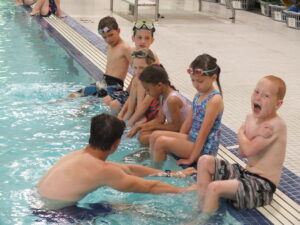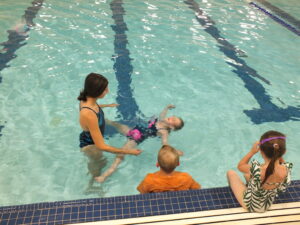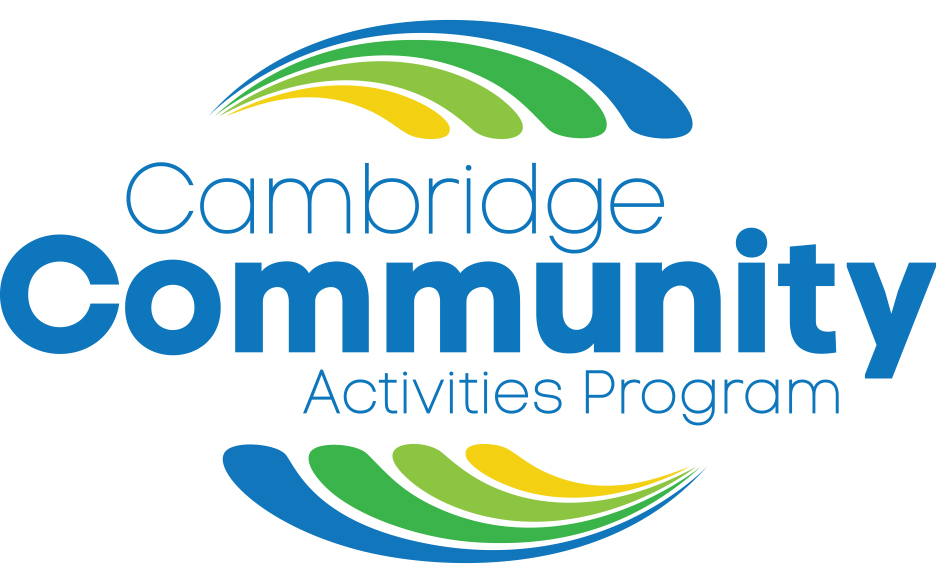

Swim Lesson Information
The Cambridge Pool is excited to offer Swim lessons for all ages! Along with teaching children how to be safer in and around water, we also introduce them to life skills of self-confidence, perseverance, and courage. We are committed to providing an environment where your child feels safe enough to try new things and accomplish their goals. Please review all of the swim lesson information and level descriptions carefully to ensure you enroll your child in the correct level. Should you have any questions or concerns, please don’t hesitate to reach out via email or phone: [email protected] | (608) 423-8097
What level do I put my swimmer in?
Please reference the swim level descriptions and prerequisites below for more information about which level is the best fit for you swimmer!
Can my swimmer use goggles?
Yes, we would love for your child to bring and use goggles!
When should I anticipate my swimmer passing into the next level?
We advise you NOT to anticipate your child passing. Swim lessons are not like school and students progress at different rates. It is not unusual for your child to repeat the same level several times. Try not to compare your child with others, instead concentrate on their ability to physically and mentally perform each skill. If your child is registered for the wrong class, transfers will be made only on a space availability basis. Progress reports will be given midway through group lessons suggesting which level your child should be placed in next!
Swim Lesson Pricing
Type of Lesson | Resident | Non-Resident |
$55 per session | $70 per session | |
$35 per half hour 5 lessons for $125 | same as resident | |
$50 per half hour $200 for 5 lessons | same as resident | |
$63 per half hour $252 for 5 lessons | same as resident | |
$75 per half hour $300 for 5 lessons | same as resident |
Are you interested in Private Swim Lessons?
Parent/Child Aquatics
Instructor Ratio 1:10
Min. of 3 children per class
Prerequisite: None
Parent/Child A: 6mo – 2 year olds
Parent/Child A introduces basic skills to parents and children. Parents learn how to safely work with their child in the water, including how to appropriately support and hold their child in the water and how to prepare and encourage their child to participate fully and try the skills. Children receive an introduction to basic skills that lay a foundation for learning to swim. In addition, parents are introduced to several water safety topics. This class is recommended for 6 month to two years old.
Parent/Child B: 2-5 year olds
Parent/Child B builds on the skills introduced in Parent/Child A. Participants improve on these skills and learn more advanced skills in this class including water entry and exit and buoyancy on both the front and back. Water safety topics are also included in this level. It is not a requirement to take Parent/Child A, but is recommended based on skill level. This class is recommended for two to five year olds.
Preschool Aquatics (Ages 3-5)
Instructor Ratio 1:6
Min. 3 children per class
Skippers 1:
The purpose of this class is to familiarize children to the aquatic environment and help them acquire rudimentary basic aquatic skills including but not limited to submerging the face in water, retrieving submerged objects in shallow water, swimming on their front and back, and water safety practices. We will work on developing positive attitudes and safe practices in and around water! Recommended for 3 to 5 year olds.
Prerequisites: No skill prerequisites.
Skippers 2:
The objectives of Skippers 2 are to further develop basic aquatic skills. Children begin to perform these skills at a slightly more advanced level (for example, for longer lengths of time, for longer distances or in deeper water). Many skills in Skippers 1 are performed with assistance. Skippers 2 marks the beginning of independent aquatic locomotion skills. Children continue to explore using simultaneous and alternating arm and leg actions on the front and back to gain greater proficiency in preparation for performing strokes. Skippers 2 also builds on the water safety topics introduced in Skippers 1.Recommended for 3 to 5 year olds.
Prerequisites: Successful completion of Skippers 1 and/or successful demonstration of the Skippers 1 exit skills including entering the water independently, gliding on the front, floating on the back, submerging the face and blowing bubbles, and exiting the water safely. This is not a comprehensive list of skills needed to be prepared for Skippers 2, but rather a guide to help determine placement.
Skippers 3:
The objective of Skippers 3 is to increase children’s proficiency in performing previously learned skills. This is accomplished by providing additional guided practice and increasing repetitions, distances, times or levels of refinement. The skills in Skippers 3 are performed independently. Children improve their coordination and control of combined simultaneous arm and leg actions and alternating arm and leg actions. New water safety topics are introduced, and previously acquired water safety knowledge and skills are reinforced. Recommended for 3 to 5 year olds.
Prerequisites: Successful completion of Skippers 2 and/or successful demonstration of the Skippers 2 exit skills including gliding on the front and flipping to the back to float for 15 seconds, gliding on the back, ability to recover a vertical position, and swimming using combined leg and arm action. This is not a comprehensive list of skills needed to be prepared for Skippers 3, but rather a guide to help determine placement.
School Age Aquatics (Ages 5-12)
Instructor Ratio 1:6
Min. 3 children per class
Level 1, Introduction to Water Skills
Level 1 introduces basic aquatic skills, which participants continue to build on as they progress through Learn-to-Swim Levels. In addition, participants start developing positive attitudes, effective swimming habits and safe practices in and around the water. Level 1 skills may overlap with the Skippers 1 and Skippers 2 skills. Skills worked on in Level 1 include but are not limited to bobbing, submerging the face and blowing bubbles, gliding on the front and back, swimming on the front and back using arms and legs, and water safety. Recommended for 5 to 12 year olds.
Prerequisites: No skill prerequisites.
Level 2, Fundamental Aquatic Skills
The objective of Level 2 is to give participants success with fundamental skills. Many of the skills taught in this level are the similar skills taught in Skippers 3. This level marks the beginning of true locomotion skills. Participants learn to glide and float without support and recover to a vertical position. Participants further develop simultaneous and alternating arm and leg actions on the front and back, laying the foundation for future strokes. New water safety topics are introduced, and previously acquired water safety knowledge and skills are reinforced. Recommended for 5 to 12 year olds.
Prerequisites: Successful completion of Level 1 and/or successful demonstration of the Level 1 exit skills including entering the water independently, traveling 5 yards in the water, bobbing, gliding on the front, rolling to the back to float, and recovering to a vertical position. This is not a comprehensive list of skills needed to be prepared for Level 2, but rather a guide to help determine placement.
Level 3, Stroke Development
The objectives of Level 3 are to expand proficiency of previously learned skills by providing additional guided practice. Participants learn and practice survival floating and learn to swim front crawl and elementary backstroke at rudimentary proficiency levels. You introduce the scissors and dolphin kicks and extend the time duration for treading water. Participants also learn rules for headfirst entries and begin to learn to enter the water headfirst from a seated position at poolside (if the water is 9 feet deep or deeper). New and previously addressed water safety topics are included. Recommended for 5 to 12 year olds.
Prerequisites: Successful completion of Level 2 and/or successful demonstration of the Level 2 exit skills including float or tread water for 15 seconds in chest-deep water, swim on front or back for 5 body lengths, transition from back float to front to vertical position, and push off and swim using combined leg and arm actions. This is not a comprehensive list of skills needed to be prepared for Level 3, but rather a guide to help determine placement.
Level 4, Stroke Improvement
In Level 4, participants improve their aquatic skills and increase their endurance by swimming the strokes learned in Level 3 (i.e., front crawl, elementary backstroke) for greater distances and with more advanced proficiency. Participants add arm actions to the previously learned scissors kick and breaststroke kick to perform the rudimentary sidestroke and to learn the breaststroke. Participants also begin to learn the back crawl and butterfly, as well as the basics of performing a simple open turn at a wall. Recommended for 5 to 12 year olds.
Prerequisites: Successful completion of Level 3 and/or successful demonstration of the Level 3 exit skills including jumping into deep water and recovering to surface, treading or floating for one minute, and swimming front crawl and elementary backstroke for 25 yards. This is not a comprehensive list of skills needed to be prepared for Level 4, but rather a guide to help determine placement.
Level 5, Stroke Refinement
In Level 5, participants refine their performance of all six strokes (i.e., front crawl, back crawl, butterfly, breaststroke, elementary backstroke and sidestroke) and increase the distances that they swim. Participants also learn to perform flip turns on the front and back. Recommended for 5 to 12 year olds.
Prerequisites: Successful completion of Level 4 and/or successful demonstration of the Level 4 exit skills including swimming front crawl for 25 yards, changing direction and position as necessary and swimming elementary backstroke for 25 yards, backstroke for 15 yards, submerge and swim 3 to 5 body lengths underwater and safely returning to surface. This is not a comprehensive list of skills needed to be prepared for Level 5, but rather a guide to help determine placement.
Level 6, Swimming and Skill Proficiency – Fitness Swimming
The objective of this Level is to refine strokes so participants swim them with greater efficiency and effectiveness over longer distances. This class will also work on different types of turns and dives as well as water safety skills.
Prerequisites: Successful completion of Level 5 and/or successful demonstration of the Level 5 exit skills including performing a shallow-angle dive in deep water, front crawl and elementary backstroke for 50 yards using appropriate turns, and breaststroke for 25 yards. This is not a comprehensive list of skills needed to be prepared for Level 6, but rather a guide to help determine placement.
Important Notes
If the classes do not fill, classes may be combined with the level above or below it (i.e a Skippers 1/2 class or a Level 4/5 class)
Instructors typically hand out Progress Reports after Week 3 to indicate what level the swimmer is on track to take next.
Report Cards will be handed out on the last day of lessons indicating if the swimmer passed the class or needs to repeat it. Repeating the same level is not uncommon!
